History
The same year that Seebeck made his discovery
about thermoelectricity, Sir Humphrey Davy announced
that the resistivity of metals showed a marked
temperature dependence. Fifty years later, Sir William
Siemens proffered the use of platinum as the element in
a resistance thermometer. His choice proved most
propitious, as platinum is used to this day as the
primary element in all high-accuracy resistance
thermometers. In fact, the Platinum Resistance
Temperature Detector, or PRTD, is used today as an
interpolation standard from the oxygen point
(-182.96°C) to the antimony point (630.74°C).
Platinum is especially suited to this purpose, as it can
withstand high temperatures while maintaining excellent
stability. As a noble metal, it shows limited susceptibility
to contamination.
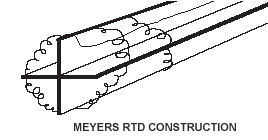 The classical resistance temperature detector (RTD)
construction using platinum was proposed by C.H.
Meyers in 1932. He wound a helical coil of platinum on
a crossed mica web and mounted the assembly inside
a glass tube. This construction minimized strain on the
wire while maximizing resistance.
The classical resistance temperature detector (RTD)
construction using platinum was proposed by C.H.
Meyers in 1932. He wound a helical coil of platinum on
a crossed mica web and mounted the assembly inside
a glass tube. This construction minimized strain on the
wire while maximizing resistance.
Although this construction produces a very stable
element, the thermal contact between the platinum and
the measured point is quite poor. This results in a slow
thermal response time. The fragility of the structure
limits its use today primarily to that of a laboratory
standard.
Another laboratory standard has taken the place of
Meyers’ design. This is the bird-cageelement proposed
by Evans and Burns. The platinum element remains
largely unsupported, which allows it to move freely
when expanded or contracted by temperature
variations.
Strain-induced resistance changes over time and
temperature are thus minimized, and the bird-cage
becomes the ultimate laboratory standard. Due to the
unsupported structure and subsequent susceptibility to
vibration, this configuration is still a bit too fragile for
industrial environments.
A more rugged construction technique is shown in
Figure 37. The platinum wire is bifilar wound on a glass
or ceramic bobbin. The bifilar winding reduces the
effective enclosed area of the coil to minimize magnetic
pickup and its related noise. Once the wire is wound
onto the bobbin, the assembly is then sealed with a
coating of molten glass. The sealing process assures
that the RTD will maintain its integrity under extreme
vibration, but it also limits the expansion of the platinum
metal at high temperatures. Unless the coefficients of
expansion of the platinum and the bobbin match
perfectly, stress will be placed on the wire as the
temperature changes, resulting in a strain-induced
resistance change. This may result in a permanent
change in the resistance of the wire.
There are partially supported versions of the RTD
which offer a compromise between the bird-cage
approach and the sealed helix. One such approach
uses a platinum helix threaded through a ceramic
cylinder and affixed via glass-frit. These devices will
maintain excellent stability in moderately rugged
vibrational applications.
TYPICAL RTD’s (FIgures 36 and 37)
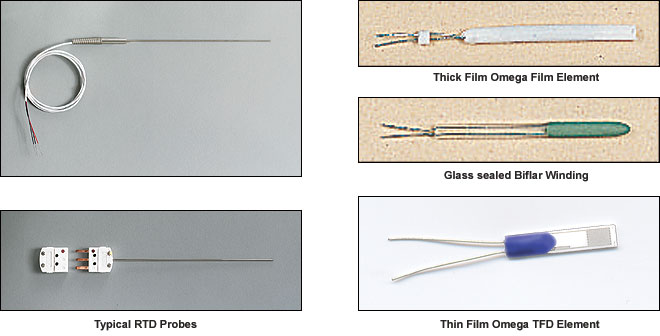
Metal Film RTD’s
In the newest construction technique, a platinum or
metal-glass slurry film is deposited or screened onto a
small flat ceramic substrate, etched with a lasertrimming
system, and sealed. The film RTD offers
substantial reduction in assembly time and has the
further advantage of increased resistance for a given
size. Due to the manufacturing technology, the device
size itself is small, which means it can respond quickly
to step changes in temperature. Film RTD’s are
presently less stable than their hand-made
counterparts, but they are becoming more popular
because of their decided advantages in size and
production cost. These advantages should provide the
impetus for future research needed to improve stability.
Metals - All metals produce a positive change in
resistance for a positive change in temperature. This, of
course, is the main function of an RTD. As we shall
soon see, system error is minimized when the nominal
value of the RTD resistance is large. This implies a
metal wire with a high resistivity. The lower the resistivity
of the metal, the more material we will have to use.
Table 6 lists the resistivities of common RTD materials.
| METAL |
|
RESISTIVITY OHM/CMF
(cmf = circular mil foot) |
|
|
|
Gold
Silver
Copper
Platinum
Tungsten
Nickel |
Au
Ag
Cu
Pt
w
Ni |
|
|
13.00
8.8
9.26
59.00
30.00
36.00 |
|
|
Table 6
Because of their lower resistivities, gold and silver are
rarely used as RTD elements. Tungsten has a relatively
high resistivity, but is reserved for very high temperature
applications because it is extremely brittle and difficult
to work.
Copper is used occasionally as an RTD element. Its
low resistivity forces the element to be longer than a
platinum element, but its linearity and very low cost
make it an economical alternative. Its upper
temperature limit is only about 120ºC.
The most common RTD’s are made of either platinum,
nickel, or nickel alloys. The economical nickel derivative
wires are used over a limited temperature range. They
are quite non-linear and tend to drift with time. For
measurement integrity, platinum is the obvious choice.
Resistance Measurement
The common values of resistance for a platinum RTD
range from 10 ohms for the bird-cage model to several
thousand ohms for the film RTD. The single most
common value is 100 ohms at 0ºC. The DIN 43760
standard temperature coefficient of platinum wire is α =
.00385. For a 100 ohm wire, this corresponds to + 0.385
ohms/ºC at 0ºC. This value for α is actually the average
slope from 0ºC to 100ºC. The more chemically pure
platinum wire used in platinum resistance standards
has an α of +.00392 ohms/ohm/ºC.
Both the slope and the absolute value are small
numbers, especially when we consider the fact that the
measurement wires leading to the sensor may be
several ohms or even tens of ohms. A small lead
impedance can contribute a significant error to our temperature measurement.
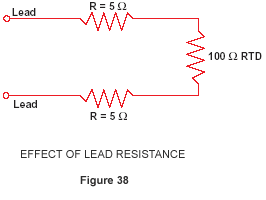
A ten ohm lead impedance implies 10/.385 ≈ 26ºC
error in measurement. Even the temperature coefficient
of the lead wire can contribute a measurable error. The
classical method of avoiding this problem has been the
use of a bridge.
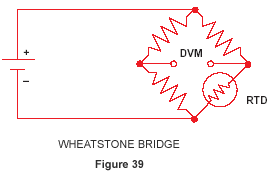
The bridge output voltage is an indirect indication of
the RTD resistance. The bridge requires four connection
wires, an external source, and three resistors that have
a zero temperature coefficient. To avoid subjecting the
three bridge-completion resistors to the same
temperature as the RTD, the RTD is separated from the
bridge by a pair of extension wires:
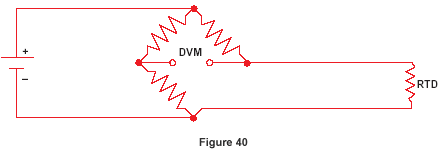
These extension wires recreate the problem that we
had initially: The impedance of the extension wires
affects the temperature reading. This effect can be
minimized by using a three-wire bridge configuration:
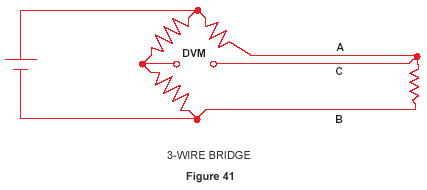
If wires A and B are perfectly matched in length, their
impedance effects will cancel because each is in an
opposite leg of the bridge. The third wire, C, acts as a
sense lead and carries no current.
The Wheatstone bridge shown in Figure 41 creates a
non-linear relationship between resistance change and
bridge output voltage change. This compounds the
already non-linear temperature-resistance characteristic
of the RTD by requiring an additional equation to convert
bridge output voltage to equivalent RTD impedance.
4-Wire Ohms - The technique of using a current
source along with a remotely sensed digital voltmeter
alleviates many problems associated with the bridge.
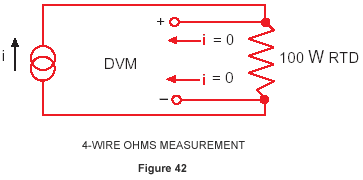
The output voltage read by the dvm is directly portional
to RTD resistance, so only one conversion equation is
necessary. The three bridge-completion resistors are
replaced by one reference resistor. The digital voltmeter
measures only the voltage dropped across the RTD and
is insensitive to the length of the lead wires.
The one disadvantage of using 4-wire ohms is that we
need one more extension wire than the 3-wire bridge.
This is a small price to pay if we are at all concerned
with the accuracy of the temperature measurement.
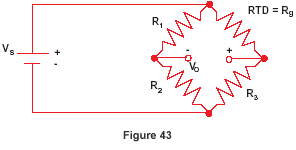
3-Wire Bridge Measurement Errors
If we know VS and VO, we can find Rg and then solve for
temperature. The unbalance voltage Vo of a bridge built
with R1 = R2 is:

If Rg = R3, VO= 0 and the bridge is balanced. This can
be done manually, but if we don’t want to do a manual
bridge balance, we can just solve for Rg in terms of VO:

This expression assumes the lead resistance is zero. If
Rg is located some distance from the bridge in a 3-wire
configuration, the lead resistance RL will appear in
series with both Rg and R3:

Again we solve for Rg:

The error term will be small if Vo is small, i.e., the
bridge is close to balance. This circuit works well with
devices like strain gauges, which change resistance
value by only a few percent, but an RTD changes
resistance dramatically with temperature. Assume the
RTD resistance is 200 ohms and the bridge is designed
for 100 ohms:

Since we don’t know the value of RL, we must use equation (a), so we get:

The correct answer is of course 200 ohms. That’s a temperature error of about 2.5ºC.
Unless you can actually measure the resistance of RL
or balance the bridge, the basic 3-wire technique is not
an accurate method for measuring absolute
temperature with an RTD. A better approach is to use a
4-wire technique.
Resistance to Temperature Conversion
The RTD is a more linear device than the
thermocouple, but it still requires curve-fitting. The
Callendar-Van Dusen equation has been used for years
to approximate the RTD curve:

Where:
| RT | = | Resistance at Temperature T |
| Ro | = | Resistance at T = 0ºC |
| α | = | Temperature coefficient at T = 0ºC ((typically +0.00392Ω/Ω/ºC)) |
| δ | = | 1.49 (typical value for .00392 platinum) |
| β | = | 0 T > 0
0. 11 (typical) T < 0 |
The exact values for coefficients α , β, and δ are
determined by testing the RTD at four temperatures and
solving the resultant equations. This familiar equation
was replaced in 1968 by a 20th order polynomial in
order to provide a more accurate curve fit.
The plot of this equation shows the RTD to be a more
linear device than the thermocouple.
|









